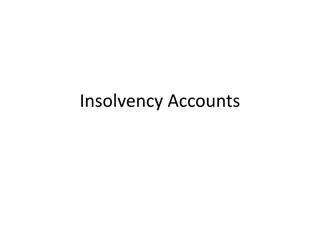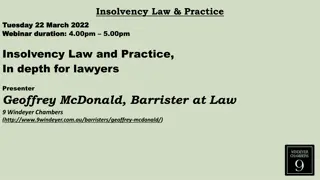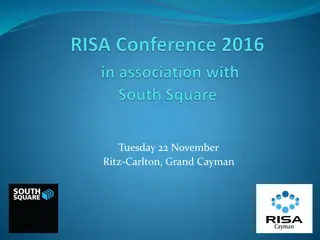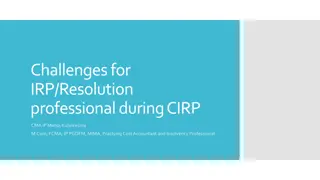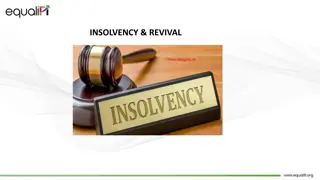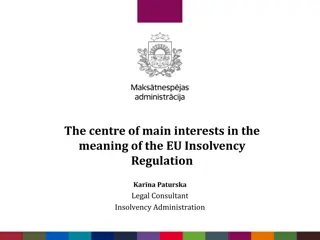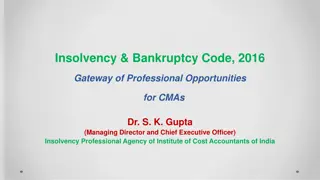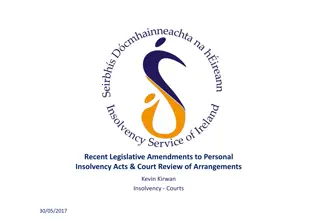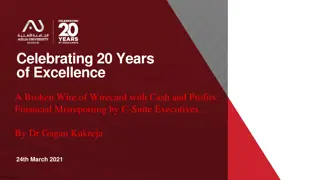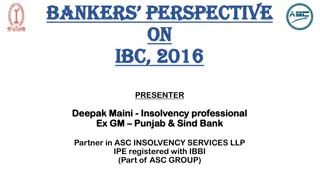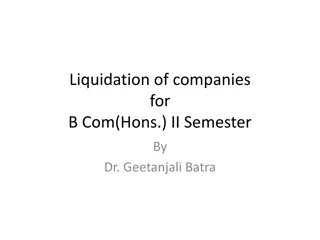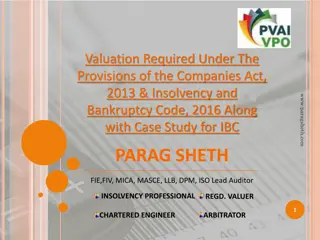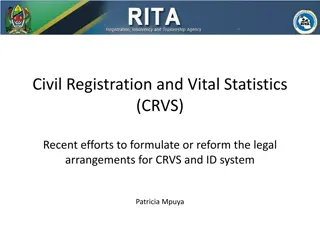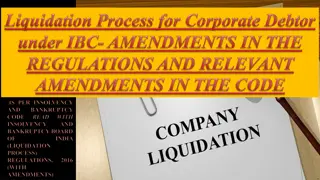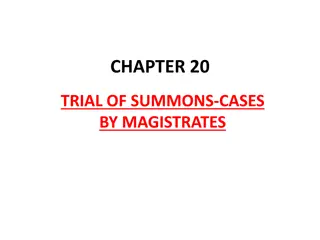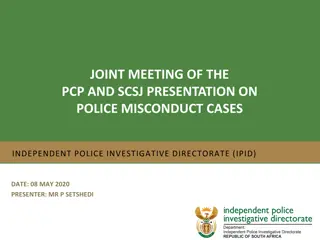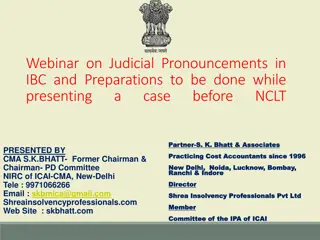Overview of Insolvency Procedures in Business and Individual Cases
Explore the different insolvency procedures such as bankruptcy, Individual Voluntary Arrangement (IVA), Company Voluntary Arrangement, Compulsory Liquidation, and Creditors Voluntary Liquidation. Understand the key aspects of each process, from initiating petitions to the appointment of IPs and the roles of directors and creditors. Gain insights into how assets are managed, powers cease, and the implications of these procedures on individuals and businesses.
Download Presentation

Please find below an Image/Link to download the presentation.
The content on the website is provided AS IS for your information and personal use only. It may not be sold, licensed, or shared on other websites without obtaining consent from the author. Download presentation by click this link. If you encounter any issues during the download, it is possible that the publisher has removed the file from their server.
E N D
Presentation Transcript
CITMA Webinar Insolvency Barbara Cookson, Filemot Technology Law Ltd Tim Pope, Drydensfairfax Solicitors
Individual Insolvency Bankruptcy Individuals including sole traders and members of partnership Creditors Bankruptcy petition if owed 5000 or more or debtors application to adjudicator Debtors assets wherever situated vest in the Trustee Normally Discharge after one year but assets at the date of bankruptcy continue to vest in the Trustee
Individual Insolvency Individual Voluntary Arrangement ( IVA ) Insolvent individual comes to an arrangement with their creditors usually to pay all or part of the individual s debts over a period of time, often three to five years, as an alternative to bankruptcy. Insolvency Practitioner, ( IP ) , will be Supervisor of the arrangement Terms governed by the IVA proposal IPR usually included in the Arrangement and subject to a trust in favour of the Supervisor If debtor complies with the terms of the arrangement over the period of the arrangement debts which were subject to the arrangement will be written off.
Corporate Insolvency Company Voluntary Arrangement Similar Process to IVA for limited companies with IP as Supervisor IP/lawyers draft proposal for approval or amendment by creditors Directors remain in control of the Company CVA will often involve the company making monthly or staged payments into the arrangement and may also involve them taking certain actions within a particular time. IPR will remain in the Company but subject to any terms of the arrangement
Corporate Insolvency Compulsory Liquidation Company is wound up by the Court following a winding up petition being issued by a creditor with IP appointed as Liquidator Liquidators role is to realise assets of the Company Directors powers effectively cease on Liquidation IPR remains in the Company Covid Restrictions on issue of winding up petitions until 31 March 2021
Corporate Insolvency Creditors Voluntary Liquidation Voluntary alternative to Compulsory Process, Company shareholders pass resolution for winding up and nominate an IP as Liquidator Liquidators role is to realise assets of the Company Directors powers effectively cease on Liquidation IPR remains vested in the Company Liquidator can bring actions in respect of assets, including IPR, transferred at an undervalue
Corporate Insolvency Administration Administration applies to limited companies and partnerships. Designed to protect a company from its creditors while a restructuring plan is completed and the company is trading normally or it can be used to effect a pre pack sale of the business. Company is subject to a moratorium whilst in Administration with very limited opportunities for creditors to take action against it unless the administrator or the Court consents Administrators can be appointed by the company or its directors, by the court or by the holder of a qualifying floating charge over the assets of the business. As in a liquidation any IPR will remain in the company in administration and will dealt with by the Administrator.
Corporate Insolvency Company Moratorium The Corporate Insolvency and Governance Act (CIGA 2020) provides for a new insolvency process whereby directors of insolvent companies or companies that are likely to become insolvent can claim a 20-business day moratorium period. This is designed to allow viable businesses time to restructure or seek new investment free from creditor action. The moratorium is overseen by an insolvency practitioner acting as a monitor but the directors will remain in charge of running the business on a day to day basis (known as Debtor in Possession process with the company being the debtor) subject to certain constraints. The moratorium can be extended either by consent from the creditors or by application to the Court.
Dissolved Companies It is a regular occurrence that companies holding trademarks or patents become dormant and are subsequently dissolved and struck off the Companies Register. When a company is dissolved, all of its assets pass to the Crown and are legally known as 'bona vacantia' (ownerless property). The Government Legal Department, (formerly known as the Treasury Solicitors), deal with such assets. Dissolved companies can be restored either by their directors or shareholders by way of administrative restoration or by way of an application to the Court.
General Points 1 Check exactly what name the IPR is registered in, often it is not the main company or has been left in the name of the original holder. Check the status of the registration vis a vis unpaid fees, often a problem in insolvency cases. Check whether there has been any recent dealing, the Jaeger trade mark sale prior to the previous administration shows how controversial that can be, as the creditors felt that stripping out the trade mark substantially reduced the value of the company. You should always be mindful of potential sales of IPR at an undervalue, known as a Transaction at an Undervalue in insolvency terms. ( Lunar Holdings Case )
General Points 2 Check exactly who you are acting for and being paid by. The IP will often require an urgent valuation for any sale, so liaison with expert valuers important, the IPR can be the biggest asset in some insolvencies. Sales by insolvency practitioners are invariably with no warranties as to the status or enforceability of IPR so if acting for buyers be prepared to give a realistic view of the risks involved. It is always important to check on any termination on insolvency provisions in any contracts governing the licence or use of the IPR. These can be many and varied, giving the parties step in rights, rights to an automatic assignment etc. Potential Disclaimer by IP
CITMA Webinar Insolvency Barbara Cookson, Filemot Technology Law Ltd Tim Pope, Drydensfairfax Solicitors
Pre-assignment check Lunar Holdings Ltd v Lunar Automotive Ltd, 2020 WL 06811385 (2020) Solvency of assignor Valuation undervalue risk Profits available for distribution Licences Co-existence Agreements
Litigating on the brink Response Clothing Ltd v The Edinburgh Woollen Mill Ltd [2020] EWHC 148 (IPEC) [2020] F.S.R. 25 Costs [2020] EWHC 721 (IPEC)
Changes to Pre-Packs https://www.gov.uk/government/publications/pre-pack- sales-in-administration/pre-pack-sales-in-administration- report#review-findings The Government have published draft legislation which aims to provide clarity for connected party pre-pack sales. The legislation includes provisions to refer the sale to an independent evaluator who will inspect / sanction the sale to a connected party and also the need to obtain creditor approval if the sale take place to a connected party within 8 weeks of the appointment. https://assets.publishing.service.gov.uk/government/uploads/system/uploads/attachment_data/file/922230/ Draftregulationstext_1.pdf


